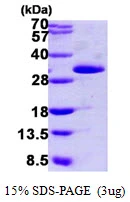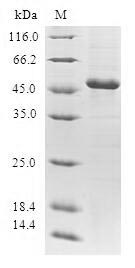Fc (human):Grancalcin (human) (rec.)
AG-40B-0242
Protein IDP28676
Product group Proteins / Signaling Molecules
Overview
- SupplierAdipoGen Life Sciences
- Product NameFc (human):Grancalcin (human) (rec.)
- Delivery Days Customer10
- CertificationResearch Use Only
- Concentration1 mg/ml
- Estimated Purity>95%
- Protein IDP28676
- Protein NameGrancalcin
- Scientific DescriptionGrancalcin is a member of a new family of proteins named penta-EF-hand (PEF), which contains five repetitive EF hand motifs. PEF proteins form a unique group including calpain, sorcin, grancalcin, ALG-2 (apoptosis-linked gene-2 protein) and peflin. The penta-EF hand members are Ca2+-binding proteins implicated in regulating cell migration, apoptosis and the mobilization of immune cells. Senescent cells accumulate in the bone marrow and secrete factors, termed senescence-associated secretory phenotype (SASP), that can promote skeletal aging. Recently, senescent neutrophils and macrophages in the bone marrow were shown to be critical cell types during skeletal aging releasing Grancalcin (GCA) to promote such aging. Grancalcin seems to act by competitively binding to and inactivating PlexinB2 functions in bone marrow stromal cells (BMSCs) leading to repression of osteogenesis and increase of adipogenesis. Increased Grancalcin expression in immune cells (bone marrow macrophages and in neutrophils) is due to higher endotoxin levels observed during aging. - Recombinant protein. Human Grancalcin (aa 1-217) is fused at the N-terminus to the Fc portion of human IgG1. Source: HEK 293 cells. Lyophilized. Contains PBS. Grancalcin is a member of a new family of proteins named penta-EF-hand (PEF), which contains five repetitive EF hand motifs. PEF proteins form a unique group including calpain, sorcin, grancalcin, ALG-2 (apoptosis-linked gene-2 protein) and peflin. The penta-EF hand members are Ca2+-binding proteins implicated in regulating cell migration, apoptosis and the mobilization of immune cells. Senescent cells accumulate in the bone marrow and secrete factors, termed senescence-associated secretory phenotype (SASP), that can promote skeletal aging. Recently, senescent neutrophils and macrophages in the bone marrow were shown to be critical cell types during skeletal aging releasing Grancalcin (GCA) to promote such aging. Grancalcin seems to act by competitively binding to and inactivating PlexinB2 functions in bone marrow stromal cells (BMSCs) leading to repression of osteogenesis and increase of adipogenesis. Increased Grancalcin expression in immune cells (bone marrow macrophages and in neutrophils) is due to higher endotoxin levels observed during aging.
- Storage Instruction-20°C,2°C to 8°C
- UNSPSC12352202


